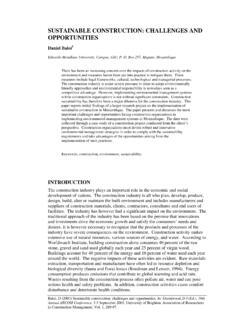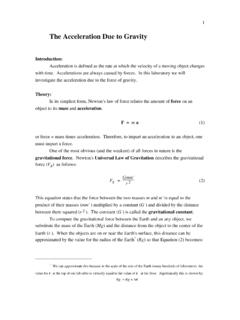Transcription of Measurement of Strain Due to Bending and Axial Loads
1 Measurement of Strain Due to Bending and Axial Loads Student Name With Partner Names Report No. ASE369K-BAS2 ASE/EM Department The University of Texas at Austin Austin, TX 78712 December 3, 2004 iMeasurement of Strain Due to Bending and Axial Loads Aluminum specimens were statically loaded for analysis in the Measurements Laboratory of W. R. Woolrich Laboratories at the University of Texas at Austin. A cantilever beam was loaded at the tip, and data was recorded from base-mounted Strain gages. Several Strain calculations were made using Strain gage resistance changes, Wheatstone bridge circuits, and a Vishay Strain gage conditioner and amplifier system. The values for Strain for the varying methods were comparable to theoretical Strain in a cantilever beam, especially the Wheatstone half-bridge circuit measurements. A tension specimen was loaded in to an Instron load cell for Axial stress analysis.
2 Stess- Strain plots were calculated based on Strain gage output, extensometer deflection measurements, and the constant cross-head speed of the load cell. Calculated strains were comparable to theoretical data, except for the Strain based on the constant cross-head speed. Deflection in the end sections of the aluminum specimen as well as flexing in the load cell itself led to calculated strains that were three times higher than the theoretical Strain based on a Young s modulus of 10 million psi. This experiment allowed for valuable experience with electrical resistance Strain gages and methods by which to take Strain gage data. Table of Contents 1 2 2 Strain 2 Wheatstone Bridge 3 Calibration 4 Cantilever Beam 5 Axial 6 Accounting for Temperature 8 Quantitative Error 8 3 Apparatus and 9 9 9 The Wheatstone Bridge and its Application in Strain 9 Vishay Micro-Measurements Strain Gage Conditioner and Amplifier 11 Measurement of the Elastic Stress- Strain Curve in a Tensile 12 4 14 Cantilever Beam Strain 14 Elastic Stress- Strain Curve for a Tensile 17 5 6 20 Appendix A: Cantilever Beam Strain Uncertainty 21 Appendix B: Tension Specimen 22 Theoretical Stress vs.
3 22 Constant Cross-Head Displacement Stress vs. 22 Strain Gage Stress vs. Strain using Bridge Voltage Relations with 23 Strain Gage Stress vs. Strain using Calibration Resistances with 23 Extensometer Stress vs. 24 11 Introduction In engineering design, it is very often necessary to test hardware for stress and Strain capabilities. For example, the Boeing 777 was subjected to full-size static testing to gain knowledge of the stress and Strain potentials of the aircraft. The 777 was fitted with approximately 1500 electrical Strain gages to monitor the Loads on the vehicle during the free floating body test [1]. Accurate Measurement of Strain is crucial in the design and testing phase of nearly all aerospace vehicles. This lab focuses on the Measurement of stress and Strain through the use of Strain gages like those used in the testing of the 777.
4 Through the use of hand constructed Wheatstone bridge circuits and a Micro-Measurements Strain Gage Conditioner and Amplifier System, base Strain for a tip-loaded cantilever will be measured. The results for the differing Measurement approaches will be compared with each-other as well as with theoretical values. A tensile specimen will be axially loaded in an Instron load cell. Strain calculations based on Strain gage output, extensometer data, and the constant load cell cross-head speed will be compared in a stress- Strain plot. A brief error analysis will be performed to help justify discrepancies between various forms of Measurement and theoretical data. 22 Theory Strain Gages In this experiment, the Strain gages utilized were foil-type electrical resistance Strain gages. These gages are based on the principle that wire resistances change when the wires are subjected to mechanical Strain [2].
5 An pair of electrical resistance Strain gages can be seen in Figure 1. These gages are bonded to the surface of the specimen to be measured. As the specimen elongates or deforms, the wires in the Strain gage also elongate. This in turn causes a change in resistance and thus a change in voltage over the gage. The change in resistance is directly related to the Strain by means of the gage factor, G [4]. GRR = Therefore, a given resistance variance indicates the Strain on the surface to which the gage is bonded. Figure 1: Electrical Resistance Foil Strain Gages [3] 3 Wheatstone Bridge Circuits The resistive Wheatstone bridge circuit is frequently used in Measurement systems. A bridge circuit can be seen in Figure 2. The boxes 1-4 are either resistors or resistive transducers, depending on the bridge setup. In this lab, the active resistive transducers are the electrical resistance Strain gages.
6 For a quarter-bridge, box 1 is an active Strain gage, and all other boxes are fixed resistance resistors. In a half-bridge, boxes 1 and 2 are Strain gages, and the others are resistors [5]. By applying Kirchhoff s current and voltage laws, the output of the Wheatstone bridge circuit pictured in Figure 2 is given by + =443322114 RRRRRRRRVVexo. So, for a quarter bridge Figure 2: Wheatstone Bridge with Balance Potentiometer [4] 4114 RRVVexo =, and for a half bridge =22114 RRRRVVexo. For a Strain gage, () GLdLAALLRdR=+= =2111 where L is the specimen length, A is the specimen cross sectional area, is the Strain , and G is the gage factor [4]. Substituting in to the quarter and half-bridge equations for Vo, 41 GVVexo= and ()214 =GVVexo respectively. Therefore, the voltage output for a quarter bridge is directly proportional to the Strain that the gage is measuring.
7 The half-bridge voltage output is proportional to the difference in strains between the two gages. Calibration Resistance It is possible to find the sensitivity of a Wheatstone bridge configuration by shunting a gage of the arrangement with a known resistance. This procedure can be seen in Figure 3 where the known resistance is Rs. The simulated Strain over R2 can be found using the equation [4] 222 GRR = , where sRRRR+ = 2222. The sensitivity for the gage can then be determined by dividing the shunted output voltage by the Strain 2. 22 oVS= 5In this experiment, the Vishay amplifier system has calibration switches that place an equivalent Strain of 1000 on the bridge circuit, from which the sensitivity of the circuit can then be determined. Strains can then be calculated by solving the above equation for . In the case of a half-bridge, it is necessary to account for both stains by plugging in 1 2 so that 21 =oVS.
8 Again, calibration resistances allow for a sensitivity to be established so that output voltages can easily and accurately be converted into Strain . Cantilever Beam Bending When subjected to a point load at its tip, a cantilever beam has a linear variance in stress and Strain through the cross-section in the direction parallel to the load. The stress and Strain at the center of the beam is zero. Therefore, the Strain on the top and bottom of the beam are equal, opposite, and maximum. So for the setup in Figure 4, Strain gage G1 should read an equal and opposite Strain to that of G2. To calculate the stress [6], IMy= . Figure 3: Wheatstone Bridge with Shunt Resistor Rs [4] 6I is the moment of inertia and for a rectangular cross section, 123bhI= where b is the base and h is the height [6]. At the base of the beam, the moment isWLM=. At the surface,2hy=.
9 Plugging in to the stress equation, the stress on the surface at the base of the beam is 26bhWL= . Strain can then be directly calculated using Hooke s Law,E = [6] when assuming a maximum Poisson s ratio of To maximize the sensitivity when measuring Strain , a half-bridge circuit is utilized with Strain gages in positions 1 and 2 of Figure 2. Because the bottom gage will have a negative Strain opposite to that of gage 1, the output voltage will be approximately twice the voltage that would be seen in a quarter-bridge circuit. The surface Strain and tension can then be found by dividing the output voltage in half. Axial Tension A uniform rod in Axial tension has equal Strain through a given cross section. Figure 5 depicts a tension specimen in Axial tension similar to the bar analyzed in this experiment. The thinner section of the bar is the gage section.
10 The larger cross-sectional ends are for mounting purposes. The deflection of the bar can be used to calculate the Strain by means of the equation Figure 4: Cantilever Beam with Tip Load [4] 7L = where is the deflection and L is the length of the bar [6]. Stress in an Axial member is AP= where P is the force imparted on the bar and A is the cross-sectional area of the gage section [6]. A Wheatstone half-bridge with gages G1 and G2 on opposing sides of the bar at positions 1 and 2 of the Wheatstone bridge of Figure 2 would therefore result in an output voltage of nearly zero. To gain valuable data, a quarter-bridge or a half-bridge with the gages at positions 1 and 3 must be used. The half-bridge is more sensitive, as was the case for the cantilever. PPG1 (G2 on opposite side) Figure 5: Bar in Axial Tension [4] Accounting for Temperature Effects Changes in temperature affect Strain output.







